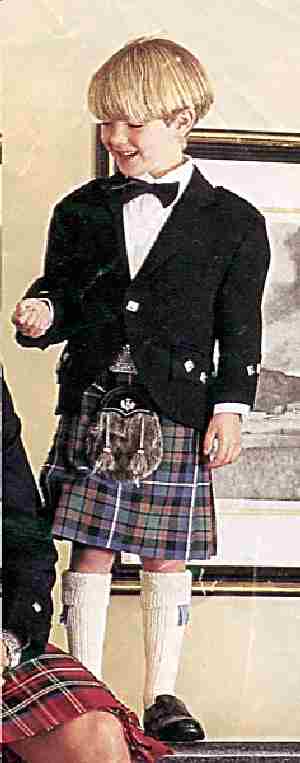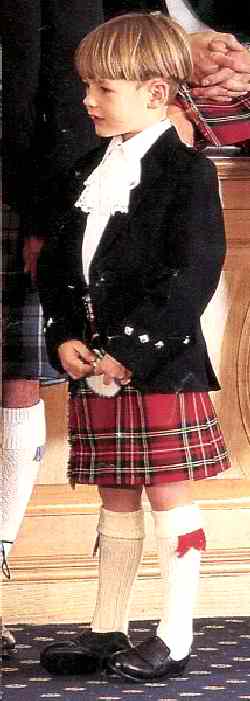
Figure 1.--This boy wears a formal pageboy outfit for a wedding in the late 20th century. Mote the bowtie and bulky kneesocks.


Figure 1.--This boy wears a formal pageboy outfit for a wedding in the late 20th century. Mote the bowtie and bulky kneesocks. |
Kilts are often worn as formal dress at Scottish weddings by the groom, attendants, and guests. Ring bearers and pages in Scotland and England
also sometimes wear kilts. HBC is not sure at this time if there were any significant differences between ring bearers and page costumes. Many formal English weddings had the ring bearer and pages in kilts, but knicker pageboy outfits are now more common. The kilt is. however, still commonly used at formal weddings in Scotland. With the kilt a black jacket and jabot is normally worn.
HBC at this time has no details on when the Sciottish likt was first employed as wedding wear for pageboys and ring bearers. As many of our wedding traditions were first establisherd in the Victorian era, it is likely that the kilt was introduced at this time. This was appear to be the most likely because the kilt was introduced as boys wear by Queen Victoria in the 1840s for her sons. Thus the kilt may have forst appeared in weddings during the 1840s and 50s. HBC has little information at this time as to stylistic differences if any, over the kilt costume worn by boys in different time periods. HBC has no early wedding images. The only difference HBC has noted has been in socks and shoes. Boys in the 1920s-50s often wore formal kilt outfits with strap shoes and sheer kneesocks or ankle socks. After the 1960s bulkier kneesocks and oxford or buckle shoes were more common.
Kilts are often worn as formal dress at Scottish weddings by the groom, attendants, and guests. Ring bearers and pages in Scotland and England
also sometimes wear kilts. HBC is not sure at this time if there were any significant differences between ring bearers and page costumes.
Many formal English weddings had the ring bearer and pages in kilts, but knicker pageboy outfits are now more common. The kilt is. however, still commonly used at formal weddings in Scotland.

Figure 2.--This boy wears a formal pageboy outfit for a wedding in the late 20th century. Note the jabot and colored flashes in the cuff of the kneesocks. |
The formal Scottish kilt outfit incudes a black jacket, jabot, kilt, and kneesocks. There have been some variations over time.
Some boys may have wore Scottish caps such as Glen Geary when going and coming from the service. Most availaible images, however, show them without caps.
The most common jacket is a black one with silver metal buttons. I'm not sure about the material.
HBC has limited information and images. Some boys may have worn blouses, but the lacey kabot was the most common shirt and neckwear. Less formal outfits might be worn with bowties.
The kilt is a standard Scottish kilt is a tartan approriate for the family. There were no special wedding kilt styles. Because of the prices of kilts they are now reserved for formal wear, but this may not have been the case in the 19th and early 20th century.
Boys in formal kilts outfits would always wear a sporan, often small sporrans especially made for boys.
Boys in the 1920s-50s often wore formal kilt outfits with sheer kneesocks or ankle socks. After the 1960s bulkier kneesocks were more common. The bulky kneesocks were always worn with colored flashes matching the kilt.
Boys in the 1920s-50s often wore formal kilt outfits with strap shoes--almosdt always black patent leather strap shoes. After the 1960s oxford or buckle shoes were more common. Another kind of shoe that looked similarnto a sandal and tied up around the ankles was also worn.
Navigate the Boys' Historical Clothing Web Site:
[Return to the Main Scottish kilt page]
[Introduction]
[Activities]
[Bibliographies]
[Biographies]
[Chronology]
[Clothing styles]
[Contributions]
[Countries]
[Boys' Clothing Home]
